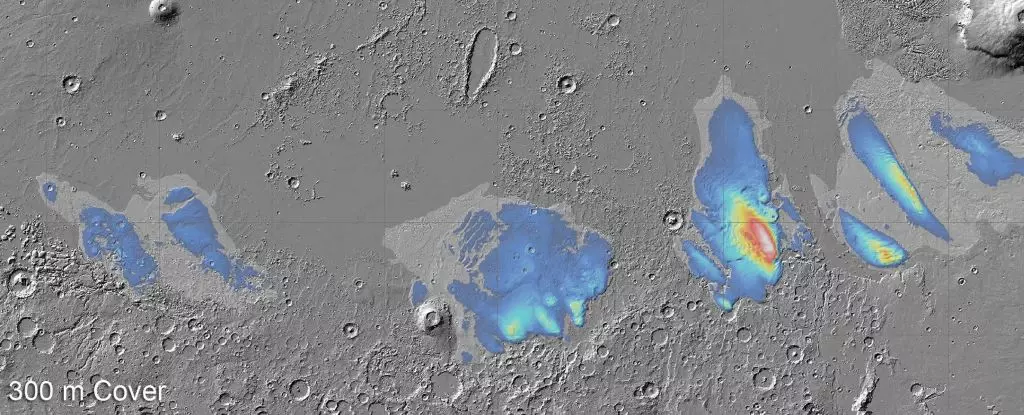Mars, the red planet, has always captivated the imagination of humanity. While its surface may initially seem barren and devoid of life, recent discoveries have unveiled some of its well-kept secrets. A groundbreaking radar survey of the Medusae Fossae Formation region on Mars has revealed the presence of massive layered slabs of buried water ice, several kilometers thick. This astonishing finding challenges our previous understanding of Mars and raises intriguing questions about its past and potential future.
Previous hints of buried water deposits in the Medusae Fossae Formation were detected in 2007, but their true nature remained a mystery. The latest data, collected using advanced tools and technology, has provided unprecedented insights into these deposits. Geologist Thomas Watters of the Smithsonian Institution explains, “We’ve explored the Medusae Fossae Formation again using newer data, and found the deposits to be even thicker than we thought: up to 3.7 kilometers thick.” The radar signals retrieved from the region match the characteristics of layered ice, resembling the signals observed from Mars’s polar caps.
The Medusae Fossae Formation spans over 5,000 kilometers along the Martian equator, effectively dividing the lowlands in the northern hemisphere from the cratered highlands in the south. The formation’s origin remains unknown, but its towering presence, reaching several kilometers in height, attests to the fierce winds that sculpt the Martian landscape. The region’s enigmatic nature has fueled scientists’ curiosity to unravel its mysteries.
In 2007, Thomas Watters and his team collected radar data that revealed the presence of something buried beneath the Martian soil. However, the true nature of these deposits remained unclear. Various possibilities, including buried dust, volcanic material, sediment from Mars’ wet past, and even water ice, were considered. To gain a more comprehensive understanding, new radar observations were conducted, and the results were meticulously analyzed. Through modeling, scientists discovered that only water ice fit the data, ruling out other possibilities. Physicist Andrea Cicchetti of the National Institute for Astrophysics in Italy emphasizes, “If the MFF was simply a giant pile of dust, we’d expect it to become compacted under its own weight. This would create something far denser than what we actually see with MARSIS. And when we modeled how different ice-free materials would behave, nothing reproduced the properties of the MFF – we need ice.”
Our understanding of Mars has drastically transformed over the last few decades. Evidence of water in the form of rivers, lakes, and oceans has emerged, indicating a very different Martian landscape in the past. While liquid water is scarce on Mars today, the question of where it went remains unresolved. Did it evaporate into space, or is it hidden within the planet’s depths? The Medusae Fossae Formation may hold vital clues to answer this enigma. Additionally, the search for water on Mars is essential for future human exploration. If water already exists on Mars, it would significantly reduce the amount of water required for sustaining life on the planet during manned missions.
Although the water ice in the Medusae Fossae Formation lies beneath hundreds of meters of Martian dust, rendering it inaccessible, this discovery sparks hope for the presence of water elsewhere on Mars. It also provides scientists with valuable information as they strive to unravel the planet’s history and transformation. Planetary scientist Colin Wilson of the European Space Agency emphasizes the significance of this finding, stating, “This latest analysis challenges our understanding of the Medusae Fossae Formation and raises as many questions as answers.” The age of these massive water ice deposits and the conditions on Mars during their formation remain intriguing mysteries that future research will strive to solve.
The revelation of extensive buried water ice deposits in the Medusae Fossae Formation shatters our previous assumptions about the water scarcity on Mars. This discovery not only offers important insights into the planet’s climatic history but also fuels the dreams of future human settlements on the red planet. As scientific advancements continue to push the boundaries of knowledge, Mars continues to astonish and surprise us, enticing us to uncover more of its hidden secrets.


Leave a Reply